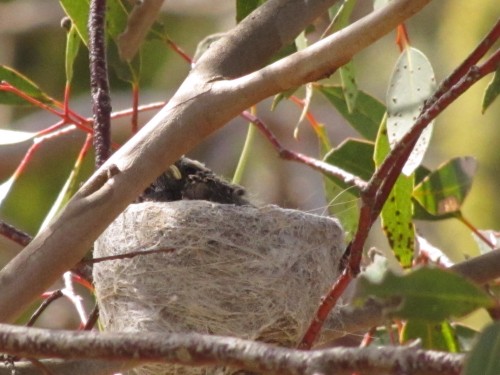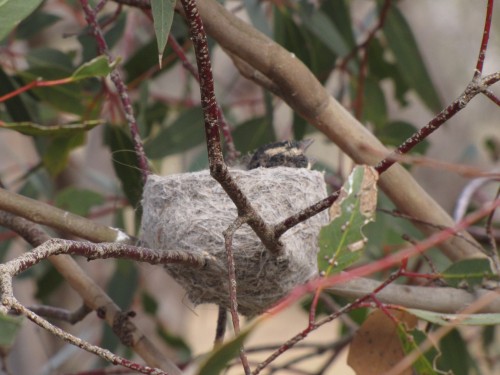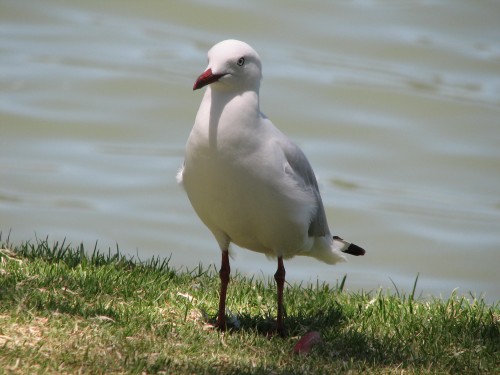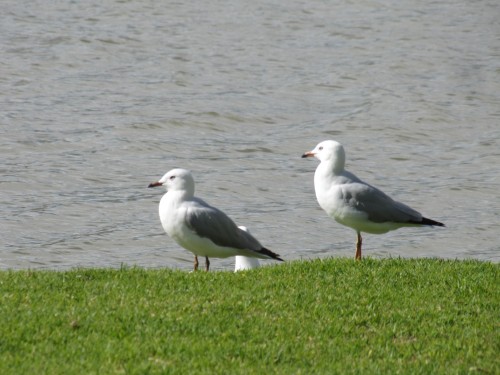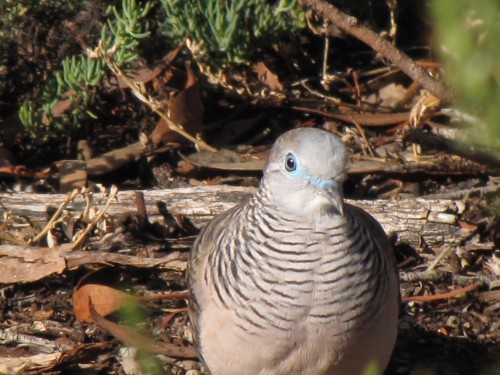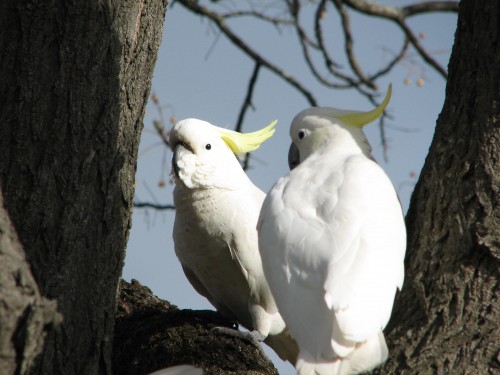Baby birds everywhere
Over the past month or so the area around our garden has been full of birds nesting, sitting on eggs, feeding young or busy feeding the fledglings after they leave their nest. Spring time here in South Australia is the main breeding season for many species of birds, especially the bush birds. Many of our trees and shrubs are also flowering which means plenty of food for the birds, both the nectivorous and insectivorous species.
Here is an annotated list of the species I have observed nesting or feeding young this spring, plus a few species I suspect have been nesting nearby. All of these observations have been in our garden or on our 5 acre property in Murray Bridge, South Australia.
- Willie Wagtail – the photos of the nest (above and below) on today’s post are of the nest with two babies just peeping over the top of the beautiful cobweb lined nest. They have since fledged and are flying around begging for food.
- Australian Magpie – I knew that our resident magpies were nesting but it was only when the young started calling to be fed that I found the nest. They had made a nest in a completely new tree this year. Last year’s nest tree was blown over by one of our winter storms. (Must cut it up for firewood.)
- House Sparrow – these seem to be always nesting, not just in the spring.
- Common Starling – about a dozen tree hollows had nests in them and it is quite obvious when there are babies in the nest; their calling for food is incessant. Most of the starlings have now flown off to the fruit growing districts nearby.
- Red Wattlebird – there have been several fledged young wattlebirds getting around in recent weeks. I suspect that the adults may well be nesting again. The male continues to boss all the other smaller species quite unmercifully. They don’t like sharing their food, even though there is plenty to go around.
- New Holland Honeyeater – I saw several parents feeding young just out of the nest quite a few weeks ago. They may well be nesting again, but their nests are usually well hidden in dense bushes.
- Peaceful Dove – we saw a pair mating and they have been hanging around close to the house for many weeks. I have yet to find the nest – in part due to a very bad back at present.
- Crested Pigeon – this species always seems to be breeding, but they chose a bush quite a distance from the house this spring.
- Spotted Turtledove – again, due to my back I haven’t yet found their nest.
- Galahs – this one is tragic. After many attempts at breeding over several years in a tree hollow near the house they finally hatched a brood of young, only to see them die in the nest during an unseasonably hot spell several weeks ago.
- Common Blackbird – this species often makes a nest in our garden shed, but this year they seem to be nesting next door and only visit our garden occasionally.
- Australian Magpie-Lark – again, this species has chosen to nest in the neighbour’s tall trees. They visit our garden frequently to catch food for the young.
- White-winged Chough – another species which visits frequently – except in recent weeks. I often see them down the road about a hundred metres away, so they are probably nesting there.
- Little Ravens – although several of this species visit almost daily, I have yet to record them nesting in one of our trees, preferring to keep away from the magpies’ nest, I presume.
- White-browed Babblers – it has been quite a few years since they last nested in our garden but they are regular visitors – except in recent weeks – they must be nesting somewhere nearby.
- Superb Fairy-wren – our resident pair still seems to be around the house garden, but they are very quiet and secretive about the location of their nest.
- Cuckoos – we have heard the calls of the Horsfield’s Bronze-cuckoo a few times several weeks ago but have seen no evidence that they stayed long enough to nest.
- Other possibilities: White-plumed honeyeater, Singing Honeyeater, Spiny-cheeked Honeyeater, Yellow-rumped Thornbill, Weebill, Striated Pardalote, Spotted Pardalote.
Silver Gulls behaving oddly
This afternoon while watching the cricket on television my wife called to me from the garden. A flock of about 20 birds were circling in the air above our five acre property here in Murray Bridge, South Australia. I quickly grabbed my binoculars and headed outside.
For the next ten minutes or so the loose flock of Silver Gulls soared on the breeze over head, circling around many times. They kept this up mostly silently with just an occasional soft contact call – nothing like their normal raucous, far reaching cry which is a quite familiar call. The whole time they stayed overhead near the shed, circling constantly over about a fifty metre radius. I am quite puzzled as to what they were up to. Perhaps they were feeding on flying insects but I couldn’t see exactly what they were doing, despite being able to observe individuals as they flew. Strange.
Silver Gulls are widespread throughout Australia and are very common along the entire coastline, along river courses, around lakes, dams, reservoirs, swamps and any suitable habitat and are usually associated with water, but not always. We are about five kilometres from the River Murray but we have some fly over our property every month of so, sometimes in large flocks of 50 to 100, usually quite high in the sky. This is the first time I can recall them coming so close to the ground; the flock stayed about 5-10 metres above the ground at all times.
An unusual sighting of a Chukar Partridge
Last week our neighbour popped in unexpectedly. We hadn’t chatted to her for a while so she was most welcome. She has known for years that I was interested in birds and had really enjoyed an illustrated talk about birds I gave some months ago to the local Senior Citizens group, Interestingly she had a bird field guide in her hand, open to a page showing a photo of a Chukar Partridge.
Her simple question was: ‘Is this bird found around here?’ She had never seen one before and was struggling to understand why she never seen it. She had been taking her dogs for a walk up the hill from our place. This is on the edge of Murray Bridge in South Australia and she was walking along the road through the start of an adjacent farming area.
This species is native to large areas of Eurasia. It has been introduced into Australia and I presume as game bird. In fact, some years ago some birds were released in the Gulgong area east of Dubbo in NSW. They never became established as a self-sustaining population. As there have been no sightings in recent years it is presumed they are extinct in that area.
So where did the bird seen by my neighbour originate? Interestingly, a year or so ago my cousin, who also lives here in Murray Bridge, sent me a photo of one in his garden. I can find no reference to this species being kept as an aviary bird though I guess that is one possible explanation if one has escaped. Perhaps someone has kept a few as meat birds and one escaped. Being a member of the pheasant family I guess that they are good eating. It is a wonder it has survived as we have quite a few foxes prowling the area.
I have no answers to these perplexing questions.
You can read more about this species here.

A not so Peaceful Dove
We love hearing and seeing Peaceful Doves in our garden here in Murray Bridge, South Australia. For many years this only happened occasionally, every month or so and only for a brief visit. That has changed in the last month and we see and hear them daily.
Although they are widespread throughout much of the agricultural lands of our state they are not present in large numbers anywhere. When two decided to take up residence in our garden and its adjacent patch of mallee scrub we were delighted. They often called several times a day and sometimes even came close to where we often have a cuppa or a meal on our back veranda. Several weeks ago my wife noticed these two birds mating, so I assumed that they would be soon making a nest in our scrub.
So far I have been unable to locate a nest, and knowing how skimpy the nests of pigeons and doves can be I am not surprised. On one occasion some years ago I stood underneath the nest of a Bronzewing Pigeon and counted how many eggs were in it. Just a few thin sticks thrown together almost randomly seems to be adequate for this group of birds. How the eggs stay in the nest is beyond me – and how the young stay in the nest without destroying their home is amazing.
The Peaceful Dove pair in our garden are hanging around so I am assuming they have made a nest and are sitting on eggs. One of the birds stays quite close to the house and continually calls throughout the day. Now – I love hearing the soft call of this species – don’t get me wrong. But when it goes on calling hour after hour throughout the day it gets a bit much. It is then that this beautiful little dove becomes far from peaceful.
Some unexpected visitors
This morning I did a small load of washing. I actually enjoy doing this because it gets me outside and away from the computer for a while. It also has the benefit of getting me outside where the birds are, and with my eyes cast skywards I often see birds that I might have missed – like the time I saw a Peregrine Falcon overhead in the last moments of a very fast stoop. Awesome.
It also has the benefit of being able to hear more birds and I enjoy listening to all of their calls and trying to identify them without looking. This is a good way of honing one’s identifiction skills. After over 30 years of living on our little patch of mallee scrub here in Murray Bridge, I have become accustomed to our bird life and immediately notice something different calling. That’s what happened this morning.
I had just finished hanging out the washing when I heard a bird calling loudly. Two Sulphur-crested Cockatoos had flown in and landed in our of our pine trees. I had enough time to grab the binoculars and see that they were testing out some of the cones on one of the trees. Obviously the cones where not to their taste or not ready for eating because they flew off again a minute later. I didn’t get a photo so the one above was taken some years ago in Adelaide.
This was a significant sighting for the birds in our garden. I think my memory is correct – this is only the second time in over 30 years I have recorded this species in our garden. They are not usually seen here in Murray Bridge (80km east of Adelaide) though they are very common in the Adelaide region and throughout the Adelaide Hills zone. This is despite there being plenty of suitable feeding spots and nesting hollows, especially along the River Murray. I think I heard one screeching as it flew overhead a few days ago, but I was in the foggy early morning sleep zone. I initially thought it was a Little Corella, but now I am not so sure.
Perhaps these were some scouts looking for new places to live.
